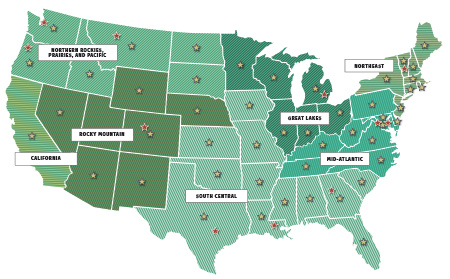A practice that offers clear benefits to farmers, wildlife, and climate is cover cropping. Cover crops are non-commodity crops planted in between rows or during fallow periods to prevent chemical leaching, soil erosion, or provide nutrients to feed commodity crops. The National Wildlife Federation recently worked with a diverse group of stakeholders to develop a road map to increase cover crop adoption in the United States.
Currently there is no measure of national cover crop adoption. The National Wildlife Federation has been encouraging federal agencies to collect data on cover crop use. By surveying cover crop seed dealers, the National Wildlife Federation discovered that less than 2 percent of cropland in the Mississippi River Basin is planted to cover crops. If more acres are planted to cover crops, there will be less water pollution from agricultural runoff. The National Wildlife Federation also spoke with water utilities, watershed conservation groups, and other individuals working hard to get more cover crops on the ground in Ohio, Michigan, Wisconsin, Indiana, Iowa, and Maryland. Read their stories in Clean Water Grows: Six Successful Cover Crop Outreach Efforts.
In 2013 the National Wildlife Federation began supporting Cover Crop Champions—cover crop leaders who can provide region-specific information and farming knowledge to farmers and crop advisors. These champions receive small grants to pay the cost of their travel, time, and various expenses to share their expertise and passion for cover crops with farmers in their region.
Calling future Cover Crop Champions! Applications are now being accepted.
Deadline: November 22, 2019
A new storymap connects the dots between extreme weather and climate change and illustrates the harm these disasters inflict on communities and wildlife.
Learn MoreTake the Clean Earth Challenge and help make the planet a happier, healthier place.
Learn MoreA groundbreaking bipartisan bill aims to address the looming wildlife crisis before it's too late, while creating sorely needed jobs.
Read MoreMore than one-third of U.S. fish and wildlife species are at risk of extinction in the coming decades. We're on the ground in seven regions across the country, collaborating with 52 state and territory affiliates to reverse the crisis and ensure wildlife thrive.
